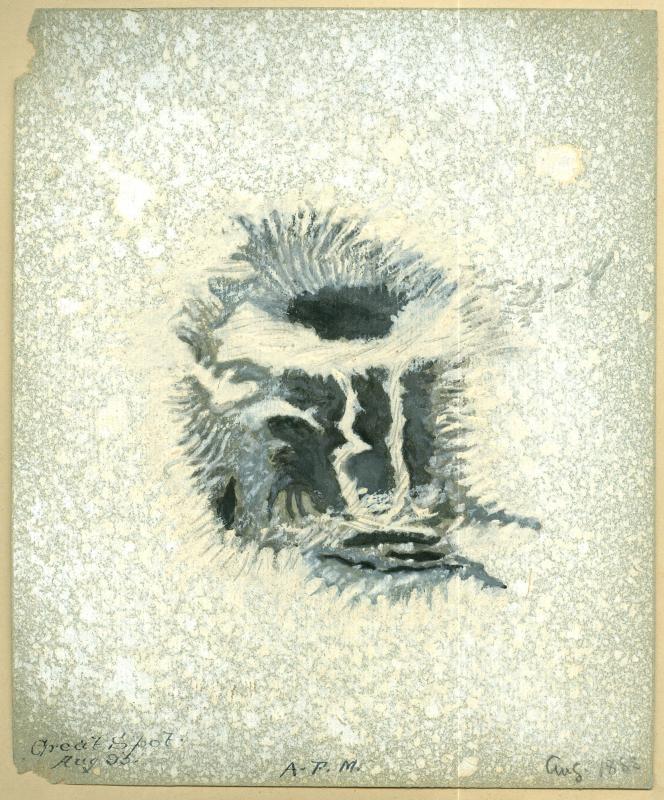Great Spot, August 1893 as sketched by A.F. Miller.
Allan F. Miller was one of the more capable and respected members of the late-Victorian RASC, he was also among the best equipped, as can be seen here, and here. His artistic style in depicting sunspots is reminiscent of that used by the much better known Abbé Moreux (e.g., Le ciel & l'univers. Astronomie moderne [Paris: Doin et Cie, 1928], planche I), but Miller's sunspot depictions have the edge over Moreux's in realism.
Attentive viewers will note a discrepancy regarding the circumstances of observation of the phenomenon recorded in thie sketch.
At the bottom left of the image is a pen & ink inscription reading
|
Great Spot. |
and approximately in the middle of the bottom of the page occur the initials A.F.M. also in pen & ink, and at the bottom right in pencil is the annotation
| Aug. 1888
|
What is going on here? Which of the two dates is the actual record of the observation, and why are two dates recorded?
1888 occurred near the minimum of Solar Cycle 12, and was a period of very limited solar activity. There were extensive periods that year during which no activity was to be seen on the Sun in white light; Sunspot and Geomagnetic-Storm Data Derived from Greenwich Observations 1875-1954 (London: Her Majesty's Stationary Office, 1955), p. 17. col. 4. That does not mean that there were no sunspots to be seen; indeed, Members of the Société Astronomique de France reported observing a large Sun-spot 1888 May 11-23, which managed to attain (but only just) naked-eye visibility. For August of that year, however, no great sunspot can be confirmed from another source.
1893 August fell approximately six months before the maximum of Solar Cycle 13, and was a period of high activity. One of the larger great sunspots on record occurred 1893 August 7 (RGO Sunspots 1955, p. 61). It was certainly noticed by amateurs - as well as by professionals (e.g., G. Riegler, The Amateur Astronomer, tr. G.A. Clarke [London-Leipsic (sic): T. Fisher Unwin, 1910], p. 160. figs. 45-46).
From the astrophysical record it seems most probable that the Great Spot observed and drawn by Miller occurred in early August of 1893. This would mean that the earlier date is in error.
The palaeographical evidence would support the conclusion from the astrophysical record. The artist's identity and the later date are in the same medium, pen & ink, and in the same hand, whereas the earlier date is in a different medium, pencil, and a different hand.
Most probable is most likely, but it is not equivalent to absolutely certain. It does not offer any clues as to why the earlier date is present. The less likely scenario, that the drawing is from 1888 August, offers one advantage, for if the sketch is a retrospective record of an observation, Aug. 1888 could be the date the original observation was made, and Aug 93 the date this graphic copy of the earlier observation was produced.
R.A. Rosenfeld

